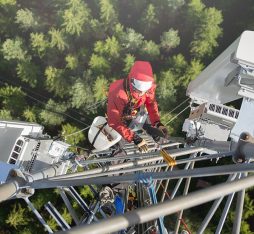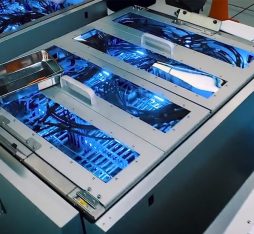“Data centre operators could become actors of the energy transition by contributing to the energy self-sufficiency of the territories in which they are established.”
Inside the data centre of tomorrow
In order to reduce a data centre’s carbon footprint, one of the first steps is to supply it with renewable energies that provide a more carbon-free source of electricity. Many internet giants, operators and hosts already power all or part of their data centres with hydro, wind, and/or solar energy.
In parallel, it is necessary to reduce the electricity consumption of existing equipment – servers, storage or network components – and to tackle the cooling systems, which make up a substantial part of overall energy consumption. Several technologies are used to make these cooling systems more energy sober, such as free cooling or immersion cooling of certain components. Soon, data centres may be totally immersed in water. In this respect, Microsoft has just validated the technical and environmental feasibility of its underwater data centre concept.
What about tomorrow?
Optimised data centres thanks to AI
Artificial intelligence will come into play more and more in order to efficiently organise the architecture and operation of data centres and to optimise energy consumption of equipment.
Several tools based on machine learning are being experimented, for example for adjusting computational task schedules – or scaling the data centre right from the design phase – according to availability of renewable energies, which are intermittent by nature. The aim is to reach a 100 % renewable energy supply, 24 hours a day, 7 days a week, while guaranteeing constant quality of service. Deep reinforcement learning models are also being tested to reduce the energy used for cooling as much as possible by combining several datasets and forecasts, or to streamline resources mobilised by identifying under-performing or under-used equipment and better distributing processing operations across the various servers.
Data centres, actors of the energy transition
The data centre is also evolving from the status of simple consumer to that of energy producer. In effect, the heat generated within IT rooms is a source of energy that can be recovered for other uses, and projects of this kind are multiplying. Data centres are thus powering urban heating networks to heat homes, offices, swimming pools, greenhouses, etc.
Better still, data centre operators could become actors of the energy transition. On the one hand by speeding up the use of renewable energies, as is already being done by several digital giants, and on the other by contributing to the energy self-sufficiency of the territories in which they are established, for example by supporting the development of micro-networks. Designed to provide a reliable source of electricity for a small community, these small-scale networks enable better integration of renewable energy production. Made up of backup production, storage and smart management systems, they constitute a lever of flexibility by enabling local management and storage of intermittent renewable energies.







